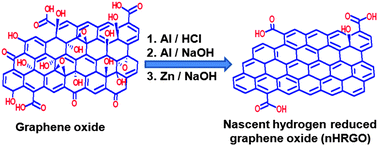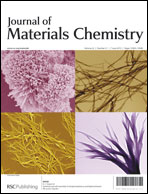Chemical reduction of an aqueous suspension of graphene oxide by nascent hydrogen†
Abstract
One of the major challenges in the chemical reduction of graphene oxide is increasing the C/O atomic ratio of the chemically converted graphene. In this paper, we report a simple and effective method to reduce aqueous suspensions of graphene oxide using nascent hydrogen generated in situ by the reaction between Al foil and HCl, Al foil and NaOH and Zn powder and NaOH. The nascent hydrogen-reduced graphene oxides (nHRGOs) were characterized by elemental analysis, UV-vis spectra, Raman spectra, X-ray photoelectron spectroscopy, thermogravimetric analysis and electrical conductivity measurements. The reduction efficiency of graphene oxide strongly depended on the reaction medium and the rate of nascent hydrogen generation. The best nHRGO achieved a C/O atomic ratio greater than 21 and a bulk electrical conductivity as high as 12 500 S m−1, corresponding to the nascent hydrogen generated from the reaction between Al foil and HCl. Since nascent hydrogen could be produced on a metal surface upon oxidation in solution, other metals with low standard reduction potentials, such as Mg, Mn, and Fe, can be applied to reduce graphene oxide.


 Please wait while we load your content...
Please wait while we load your content...